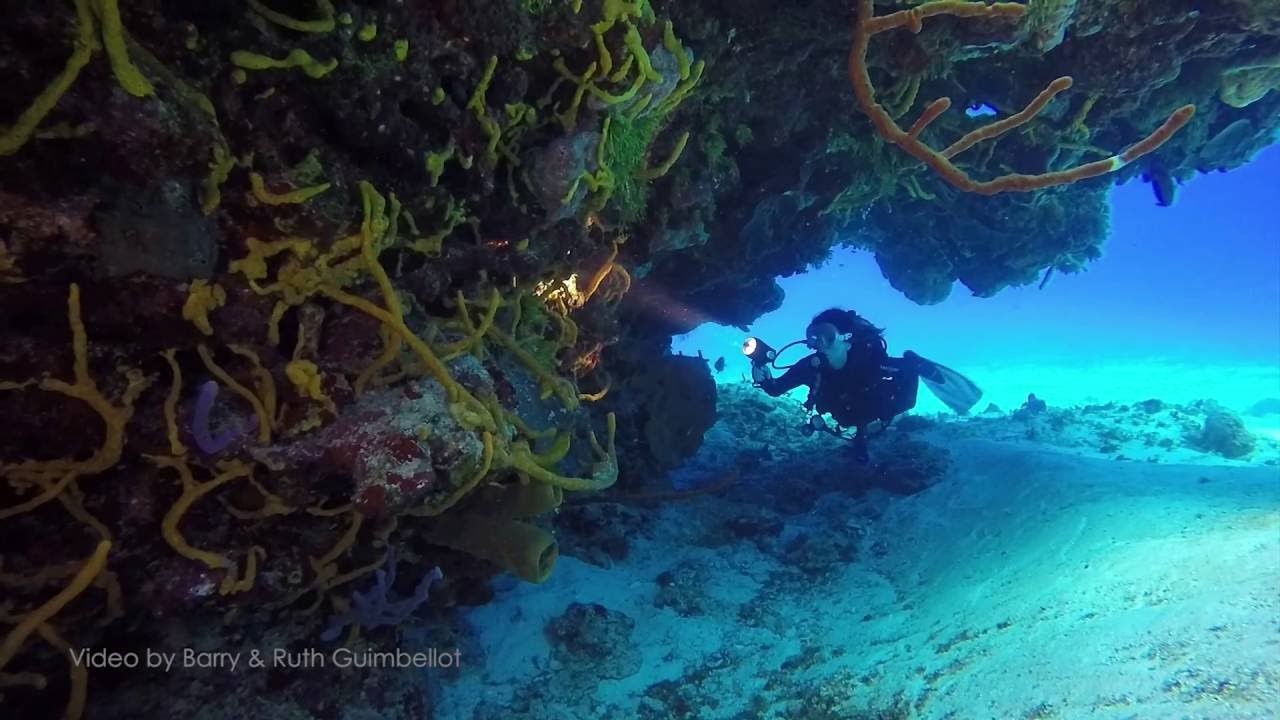“A rose by any other name would smell as sweet” but what about a dive light? Is there really that much of a difference from one compared to another? There are so many options on the market now, it can be hard to know what the best light for you is sorting through features and ignoring gimmicks is fraught with buzz words like lumens, lux and watts. For me choosing dive light comes down to three main categories: What type of diving is it for? What matters to you most? What are the features and do they make a difference. Of course everyone comes at buying kit from different perspectives so you might not agree with what I think is important and not but hopefully you will find something valuable to take away.
The first and by far and away the most important issue is what type of diving is the light for? There are obviously loads of different types of lights but I think it is easy enough to break them down into three categories: Primary Light, Secondary Lights and Video Lights. In my opinion all lights fall into one of these categories, but more importantly very very few can do crossover from one category to another.  A Primary Light is a light that you plan to us for the entire dive to see where you are going. This is might be a night dive or a wreck/cave dive, basically any type of diving where without a light you would be in total darkness. Secondary Lights are usually backup lights to you primary but are also commonly used to light up small areas like cracks and crevices during day dives. The last broad category of dive lights are Video Lights, these are usually very powerful lights that illuminate large areas. Surprise surprise they are really only of any use to photographers and videographers. I have always thought that function trumps form, so the first step in choosing a light has to be identifying what you need to use this light to do. If you need to use the light for the entire dive to see anything, get a primary. If you only want a back up or are just looking to see what’s lurking under a rock get a secondary. And if you plan on taking photos or video you would be wasting you time with anything other than a video light.
A Primary Light is a light that you plan to us for the entire dive to see where you are going. This is might be a night dive or a wreck/cave dive, basically any type of diving where without a light you would be in total darkness. Secondary Lights are usually backup lights to you primary but are also commonly used to light up small areas like cracks and crevices during day dives. The last broad category of dive lights are Video Lights, these are usually very powerful lights that illuminate large areas. Surprise surprise they are really only of any use to photographers and videographers. I have always thought that function trumps form, so the first step in choosing a light has to be identifying what you need to use this light to do. If you need to use the light for the entire dive to see anything, get a primary. If you only want a back up or are just looking to see what’s lurking under a rock get a secondary. And if you plan on taking photos or video you would be wasting you time with anything other than a video light.
Once you have decided what type of light you need, you need to come to grips with what it is that matters most in each category. When you are looking at a Primary light to start with forget about all the features expect Burn time, power level (lumens) and beam angle. All the other features pale in comparison to these three when choosing a primary. To me burn time is the most important of these three. Basically you need to know even as your light gets older and doesn’t perform as well it will easily last at least one entire dive from fully charged. It’s important to keep in mind that your primary light will be used on land during entries, exits and probably while assembling and disassembling your gear. So even though you might only aim to be diving for 50 minutes your burn time per dive is probably closer to 90 minutes. For a Primary light I think the minimum burn time you should consider purchasing is 120 minutes. Any less and you may find that as you light gets older you may end up switching to you secondary more than you would like. After burn time power level/lumens are the next thing to focus on. You don’t want to have a light that will burn for 6 hours but only lights up as much as a tea light candle.
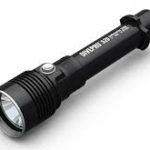
A quick disclaimer manufactures can be extremely misleading when it comes to reporting how many lumens their light has. I have included a link at the bottom of the blog if you want to understand what I mean better. Essentially I recommend higher that what is truly needed to avoid getting caught out by misleading lumen readings. So I believe when it comes to buying a primary light you should aim for at least 1200 lumens. This way you will always have enough power to really light up where you are diving. The last most important feature of a primary light is the beam angle. The beam angle describes how wide the beam of light is as it extends from the torch. A primary light should have a narrow beam angle between 6 and 10 degrees.
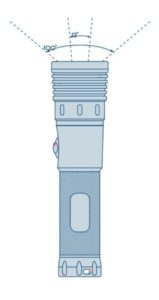
This is pretty narrow, but it’s for a good reason. The wider the beam the less penetrative power it has. Think of it this way if we had two 1000 lumens lights, one with a 8 degree beam and the other with a 40 degree beam. The 8 degree beam light might reach 30-40 meters underwater where as the 40 degree beam may only go say 10-15 meters. A narrow beam will allow you to see things better further away. To wrap up on primary lights you should be looking for something that has a long battery life (2 hours +), is reasonably bright (1200 lumens or more), and can penetrate the water far enough for you two see what’s up ahead (beam angle between 6° – 10°).
A Primary light is all about being in a completely dark environment, but a secondary light can be a little more versatile. Your secondary light can be both a “Crap! My primary failed, I’ve gotta get out of here” or an “Ooooo! That’s a big dark hole; I wonder what’s living in it?” I think when choosing a primary we should focus on its size, burn time, and lumens. Size matters! But bigger isn’t better when it comes to your secondary light. Not even the most pretentious Tec Divers want to carry two primary dive lights just in case one of them fails. A Secondary light should be small enough that it can be stored comfortably in a BCD pocket attached to the webbing on a harness. Be careful not to go so small that it is impractical to use, you don’t want to be fumbling around in the dark trying to turn it on. I think the ideal dimensions for a secondary dive light are between 140mm to 200mm long and 20mm-35mm wide. As far as burn time goes, since you aren’t planning on using this light for the entire duration of a dive we don’t need to be as worried about this as we were with the primary light. Remember that if your primary fails you should be turning around and slowly heading back to the exit, therefore your secondary only needs to last half the length of a given dive. If we assume the longest most of us ever dive is 60 minutes that would mean the minimum burn time you could get away with would be 30 minutes. We want to make sure you have plenty of burn time for use at the surface though so I would suggest looking for a secondary light with a burn time of 50 minutes or more. The last thing to consider about a secondary light is power level / lumens. My thinking is that the last thing you want when your primary fails (which can be slightly stressful) is to be squinting and guessing what it is ahead because your torch is so dim. And if you plan on using your secondary light on dives during the day you need plenty of power so you can really see a difference. I think 900 lumens and up is about right for a secondary light. This way you will be able to see clearly and because it is only used for short periods of time the high power level won’t be too much of a worry in terms of reducing burn time. All in all a secondary dive light should be compact (about the same size as a snorkel but half as long), it needs to have a burn time of at least 50 minutes and should be powerful enough that you can still see clearly if you have to use the secondary as a backup (>900 lumens).
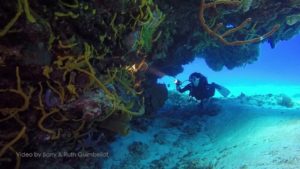
Primary and Secondary dive lights have similar purposes in that we generally want them to see what we are doing, but Video Lights are a whole other barrel of fish. The primary use of a video light is to add light, colour and contrast to underwater photos and video. That means some different features we need to focus on when deciding what to buy. If we break it down into four primary categories this gives us an easy starting point. Burn time and lumens you should be pretty familiar with by now but we also need to consider the light colour and the shadow projection. With respect to burn time, the longer the better. You want your video light to be able to last the full duration of two dives otherwise you will need to buy extra batteries. So I would recommend going for a video light with a 120 minute burn time. Since you won’t be using it at the surface we can stick to the average dive time of 60 minutes and that will be plenty. When it comes to lumens you basically want to have mini sun in a can. Since the beam angle of video lights is a minimum of 100° you need power so you can get any penetration through the water. It may sound absurd but I would aim to get a video light with at least 4000 lumens. It might be over kill when you are shooting macro (most video lights have a dimming function to combat this) but for the wide angle shots anything less just won’t cut the mustard. The next thing to keep in mind when choosing a light is the colour. Obviously I don’t mean the colour of the torch body, rather the colour of the light emitted. This is measured in degrees kelvin, there are three broad categories here: warm light – 3000°K, cool light – 4000°K, Daylight – 6000°K. Most (but not all) LED lights fall inside the cool light category. This is fine for diving but in my opinion looks clinical and almost dull.

Warm lights are more yellow and often distort colour rather than restore it so these are best avoided if possible. The clear winner for colour temperature in a video light is anything in the daylight category. This is the most natural looking and will give you the best results. Now you can always correct colour when you edit your photos and videos after the dive but the closer to natural you start with the easier this will be. Shadow projection may not be important to some people but I think this is what makes the difference between average and awesome footage. You want to have nice crisp, sharp edges to your shadows rather than a messy double exposure type effect. Having crisp shadows can only achieved by having either a single or highly condensed LED[s]. So the goal here is to go for the condensed LED’s as these typically have a higher lumen output and will still give you professional looking footage.
Choosing a dive light can be hard work, but it doesn’t need to be. The key is to know what your light will be used for. If you need something to light up the dive for the entire duration you need to be looking at Primary lights. A Primary light should have a long burn time, be significantly bring and have a narrow beam. The other option would be a secondary light more suited as a back up or a day light. These should be small and compact, burn for at least 50 minutes and be bright enough to get out of a sticky situation.
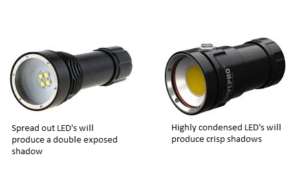
The last type of light to consider was a video light. These need to have an ungodly amount of power, 4000 lumens or more, a burn time that will last you for two dives, beam colour as close to daylight as possible and condensed LED’s to produce crisp and clean shadows. If you are still a little blurry on what is best for you, you can always swing by Dive HQ and we can walk you through it all.
Safe Diving
